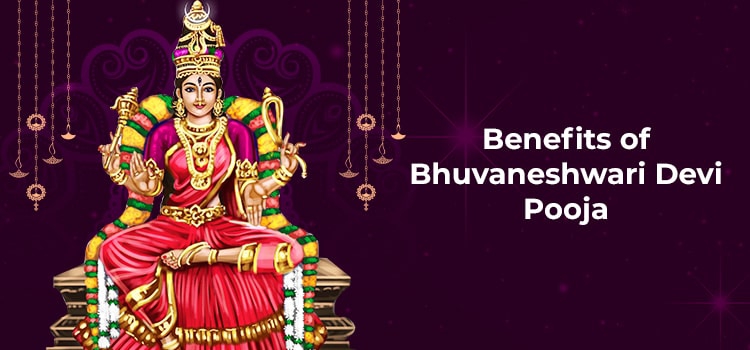Benefits of Bhuvaneshwari Devi Pooja
As per Hindu mythology, Goddess Bhuvaneshwari is the creator and ruler of the world. Her name comes from the Sanskrit words "bhuvana", meaning ‘universe’, and "ishwari", meaning ‘goddess’ or ‘queen’. She is the 4th of the Dasa Mahavidyas or Wisdom Goddesses in Hinduism.
Bhuvaneshwari is also called Durga, Parvati, and Bhagavathi. She is a manifestation of Kali, who is the fierce aspect of the Divine Mother, Shakti. Shiva, as Triyambak, is her husband (Bhuvaneswara).
Origin of Goddess Bhuvaneshwari
One popular story has it that Bhuvaneswari emerged from the cosmic ocean. She, along with the other Mahavidyas, was born to help Shiva in his fight against Andhaka, a demon. The goddesses provided Shiva with shakti, or divine energy, to kill the demon and save the universe.
Another version says that Bhuvaneswari appeared before Brahma and asked for the power to rule the entire universe. Brahma agreed, and she became the embodiment of the universe. She could now create, sustain, and destroy all things.
Yet another story claims that Goddess Bhuvaneshwari took the form of the earth goddess and has an association with the earth element or Prithvi. As the earth goddess, she is responsible for the earth's fertility, growth, and abundance.
The goddess is also associated with the element of space, which is the primary element from which all the other elements arise. Hence, she is seen as the source of all creation.

Iconography
Goddess Bhuvaneshwari is usually depicted as a beautiful woman. She has four arms, and she sits on a lotus. She holds a noose, a goad, a book, and a rosary in her hands. She is often shown holding a trident or a sword. She wears a crown or garland of skulls. The noose and goad symbolize control and guidance, while the book represents knowledge and learning. The rosary symbolizes her devotion to spiritual practice. She is often depicted in red or green attire and wearing various ornaments.
Devotees believe that Bhuvaneshwari is the source of all creation and the ultimate reality. They worship her for knowledge, wisdom, and spiritual growth, and also to remove obstacles and promote maturity. She is associated with the Mooladhara or Root chakra, which lies at the base of the spine. She rules our sense of stability, security, and survival.
Worshipping Bhuvaneshwari can activate and balance the Root chakra. It makes the practitioner feel grounded and stable. Bhuvaneshwari is a major deity in the Hindu tradition who is revered for her wisdom, power, and beauty.
The Macrocosm of Bhuvaneshwari’s Body
In some schools of Hinduism and Tantra, the macrocosm (universe) of the goddess’ body is a deeply ingrained concept. This belief comes from the notion that the universe is an extension of Shakti, the divine feminine energy, and that all aspects of creation are part of the goddess’ body.
Thus, the macrocosm, or the entire universe, is the goddess’ body. All creation, from the smallest to the largest is part of her. This creates awe for the divine and a recognition that all aspects of creation are interconnected.
The macrocosm of Bhuvaneshwari's body is supposedly in a state of constant flux. Creation and destruction occurs in an endless cycle, which is a manifestation of the goddess's energy, that is continually creating and sustaining the universe.
Such beliefs create a sense of compassion and interdependence. If all creatures are part of the goddess’ body, harming others is like attacking the goddess herself. This thought creates a sense of unity and interconnectedness and reverence for all creation.
Bhuvaneshwari Devi Pooja
Rama worshipped Bhuvaneshwari before he waged war against Ravana to rescue Sita, and achieved victory. Bhuvaneshwari Devi Pooja is performed by devotees who seek a happy married life. Bhuvaneshwari Jayanti, or the birth anniversary of Bhuvaneshwari, is on Shukla Paksha Dwadashi, the 12th day of Bhadrapada.
Bhuvaneshwari has 64 celestial characteristics. She helps the devotee to achieve their goals and fulfill their aspirations. The Pooja can be performed on the first Monday of any Hindu month. The Pooja removes obstacles and bestows traits like courage, self-assurance, sensitivity, responsibility, and emotional maturity. It can also remove the malefic effects of the Moon.
Benefits of Bhuvaneshwari Pooja and Yajna
∙ It bestows name and fame.
∙ It gives strength and achievement.
∙ It can eliminate planetary doshas.
∙ It can counteract the negative effects of the Moon.
∙ It frees one from misery, attachment, and delusion.
∙ It can remove barriers.
∙ It bestows emotional maturity, valor, sensitivity, and self-assurance
Rituals of Worship
Bhuvaneshwari Devi Pooja involves several offerings and rituals.
Flowers: Devotees offer fresh flowers, especially red or white flowers, during the worship, as they are auspicious.
Lighting Incense: Lighting incense is an important aspect of the Pooja. It purifies the surroundings and leads to a conducive atmosphere.
Fruits and Sweets: People offer fruits and sweets to the goddess to show their devotion and gratitude.
Chanting of Mantras: Goddess Bhuvaneshwari Mantras, like the Bhuvaneshwari Ashtakam or the Bhuvaneswari Kavacham, are chanted.
Meditation: Meditation is also a common practice for worshipping the goddess. People meditate on the form and qualities of the goddess and invoke her blessings for spiritual growth and inner peace.
Yantra Worship: Yantras are also part of her worship. Bhuvaneshwari Yantra is a powerful tool for gaining the goddess’ blessings.



















